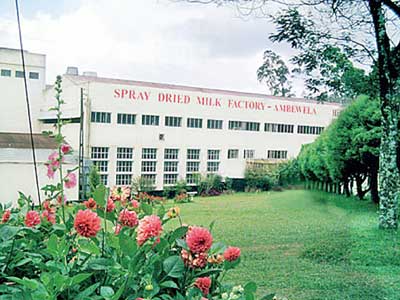Saturday Dec 06, 2025
Saturday Dec 06, 2025
Wednesday, 18 November 2015 00:37 - - {{hitsCtrl.values.hits}}
By Waruni Paranagamage
State-owned dairy manufacturing firm MILCO is confident of expanding its production capacity by twofold next year.
MILCO General Manager Sudath Munasinghe yesterday told the Daily FT that the company would be able to meet domestic fresh milk demand by 2016.
Munasinghe said that MILCO had already implemented a program to modernise its existing milk factories while a new factory is set to open in Badalkumbura in Gampaha District.
“Currently we cover 80% of the sanitary fresh milk collection island-wide and our production capacity is 200,000 litres per day. However the daily fresh milk production would be able to increase to 400,000litres by modernising factories and expanding production capacity,” Munasinghe added.
The Minister of Rural Economic Affairs P. Harrison last week at a meeting held with100 MILCO Highland brand dealers extended the support of the Government to develop the production capacity of MILCO to meet the local fresh milk demand. The dealers pointed out at the meeting that the current production capacity was not enough to address local demand.
In 2014 the NLDB signed an agreement with a foreign supplier to import 2,500 high yielding dairy cattle this year. The production process of the MILCO factory in Polonnaruwa was modernised in 2014 and the modernisation of factories in Digana and Ambewela was expected to be completed by the end of this year. Though MILCO expected to increase its capacity to meet about 50% of domestic dairy milk demand, the poor production capacity of the factory was unable to meet the set targets.
However, the Government focused on replacing old machines with new machines in Digana, Ambewela and Narahenpita factories.
Munasinghe expressed that further job opportunities would be generated by developing the new factory in Badalkumbura.
“Currently there are 1400 employees working in MILCO. Out of them there are so many employees that have linked with the supply chain of milk. However further job opportunities for people could be generated by expanding our production capacities,” Munasinghe added.
According to the Central Bank report, island-wide milk production grew by 1.1% to 330 million litres in 2014 and the milk collection by large collectors grew by 0.8% to 202 million litres in 2014. The milk production at National Livestock Development Board (NLDB) also increased from 8.7 million litres in 2013 to 10 million litres in 2014 with increased contribution from imported high yielding cows.
During the last two years, NLDB has imported 2,000 cows from Australia, which helped meet the industrial demand of raw milk. The Government is set to import a further 20,000 cows to expand milk production.